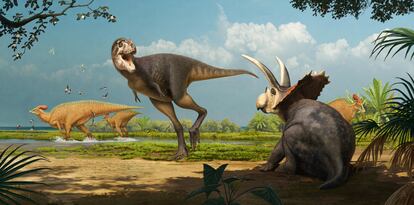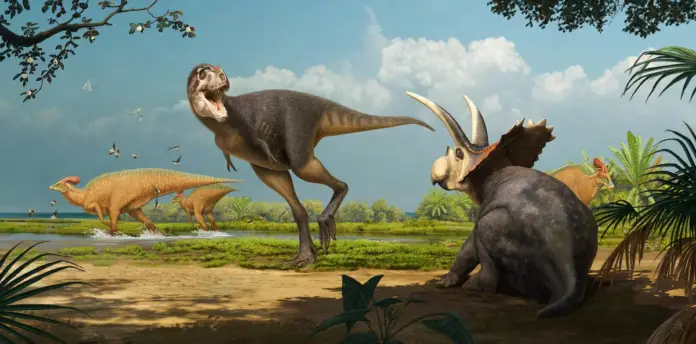
A set of bones kept safe for two decades have led to the discovery of a new carnivorous dinosaur in northern Mexico: it is the Labocania aguillonae, a powerful predator, related to the iconic Tyrannosaurus rex, which inhabited what is now Coahuila some 72.5 million years ago. Its identification not only adds to the growing diversity of dinosaurs found in the state, it also suggests that the large carnivores of the tyrannosaur family, popularized through movies, toys and animatronic robots, expanded throughout North America beyond Canada and the United States.
The first fossil remains of the species, which correspond to fragments of the jaw and skull, were discovered by Mexican paleontologist Martha Carolina Aguillón in 2000 during a series of field works in Cerro del Pueblo, a geological formation located in southern Coahuila, whose fossil records, rich in primitive flora and fauna, have positioned it in recent decades as a flagship site for the discovery of living beings that inhabited Mexico in the remote past. More than twenty years after Aguillón’s discovery, a team led by Héctor Rivera, researcher at the Desert Museum in Coahuila; and Nick Longrich, from the University of Bath in England, have described the new species in research published in September in the journal MDPI Fossil Studies.
Labocania aguillonae, named in honor of Martha Aguillón, is the second tyrannosaur found in Mexico after the discovery of Labocania anomala, described in 1974 in Baja California. It is also the first tyrannosaurus found in Coahuila, the epicenter of paleontology in the country, driven by a state campaign that has been seeking to position the state as the “land of dinosaurs” for at least a decade. With about ten and a half meters in length and elongated legs designed for speed, the Labocania aguillonae had a lighter body build than the Tyrannosaurus rex. “We cannot say that it was a complete hunter or scavenger; it had a shorter skull, a little flatter; short arms with two fingers and longer legs as well,” Rivera Sylva explains to this newspaper regarding its distinctive characteristics.
For Marta Aguillón, Labocania aguillonae represents one of the missing pieces to better understand the flora and fauna of the region 72 million years ago, when instead of the semi-desert landscape of today, Coahuila was a tropical forest with dense vegetation that made its way to the coast through deltas and swamps. “We have to consider the large number of duck-billed dinosaur finds (found in the same region). There must have been someone who controlled or regulated that ecosystem, and that is where this large carnivore comes in, which could easily feed on them,” says the paleontologist while revealing the role of the newly discovered species as main predator.
The discovery joins a series of recent indications that suggest that the diversity of dinosaur species in North America was much greater than was believed a couple of decades ago, when discoveries made in the United States and Canada dictated the norm and the possibility of finding a multitude of particular species in what is now Mexico was taken for granted. It also provides evidence to suppose that the genus that includes tyrannosaurs was highly endemic and, therefore, different species were distributed in different regions of the continent. “We are seeing that there is sufficient evidence to affirm that in terms of latitude, vegetation and climate, it is quite valid to say that in this area things were different in the north,” explains the expert. “It was always said that what we have here was very similar to what is in Canada because there was not a sufficient inventory. Now we are in a different moment in the paleontology of Mexico, and although we are still in our infancy, we are seeing exceptional things,” says Aguillón.
Source: elpais






